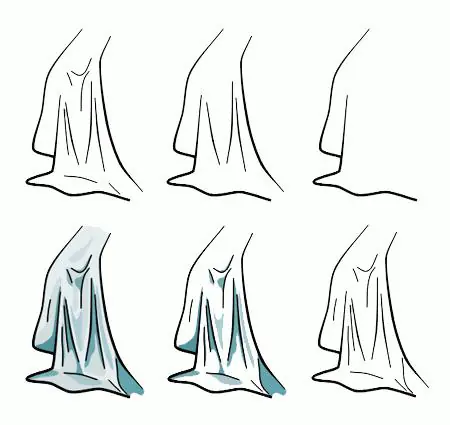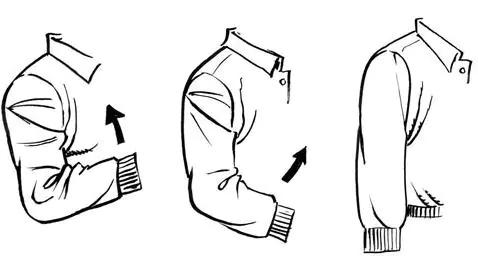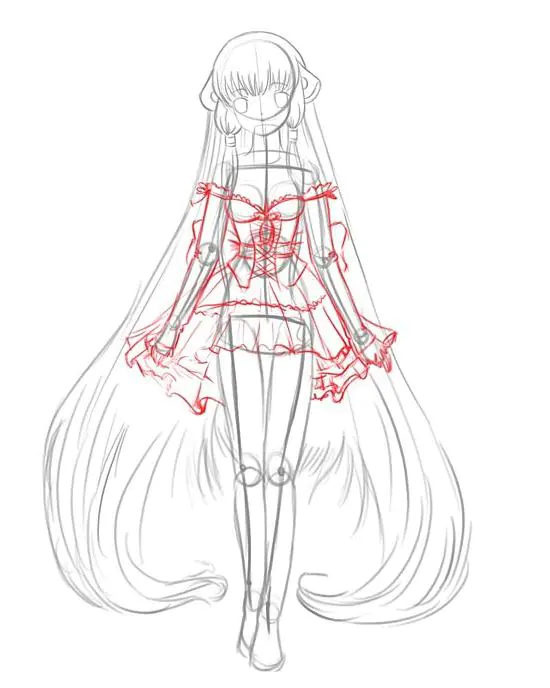Drawing is, first of all, conveying what you see or want to show others. And, of course, I want to be able to convey my thoughts correctly and clearly. When drawing any character, we also draw his clothes (almost always). And in many ways, clothing creates the impression of the character’s reality, or breaks this impression.
Before wondering how to draw clothes, let's decide what kind of clothes we want to draw, or what genre. If you just need a sketch, then familiarizing yourself with the first stages will be enough. If you are interested in learning how to draw clothes as realistically as possible, then you will have to try, because here we will need to take into account not only the shape, as in the sketch, but also shadows and folds. We will also get acquainted with the main features of drawing anime clothes.

To begin with, let's take into account that we are drawing clothes that are on the human body, that is, they do not retain a flat shape, but become voluminous, repeating the curves of the body. Let's get acquainted with three rules that will help you answer the question of how to draw clothes.
1. There is no such fold that is present or formed on clothing for no reason, that is, if you decide to draw a fold, you must be sure that it can really be there. You shouldn’t just draw like that, it’s better to think again and draw a justified fold, the appearance and existence of which you can explain. Remember that folds can be varied, they depend on the cut and fabric of the clothing, what affects the fabric, and whether the clothing fits snugly to the body. Do you still want to know how to draw clothes correctly?
2. Folds on clothes are a secondary thing; you cannot emphasize them too much, otherwise attention from the character will be diverted to the clothes, and he will simply get lost against the background, excuse me, of rags.

4. The main thing is that the clothing is on the figure, and it should be remembered that shadows and folds have an important mission - to emphasize the presence of this figure. It doesn’t matter what you draw: a headdress, shoes, outerwear or underwear - in any case, they are put on the figure.
5. Folds and shadows also show the presence of body movement. Whether the person whose clothes you're drawing is walking, sitting, or just standing, you have to show it.

Clothes in anime, of course, differ from clothes in life and films, just as animated films from different countries differ from each other. However, first you must decide what type of anime you choose to emulate. Now there are a huge variety of drawings: in some, the drawing is similar to films, that is, the presence of folds and shadows on a complex level. However, we can take an example from simpler drawings, where volume is achieved with a couple of strokes for folds, only slightly emphasizing volume and movement, and by shading part of the clothing to demonstrate its illuminated part.
If you are still interested in how to draw clothes, then first take some sample, read these rules, and don’t forget about motivation - reward yourself for mastering the skill!
Welcome! This is the first in a series of lessons that should (fingers crossed) help you understand... how to draw clothes correctly, fabrics and the like.
In this tutorial I'll be using a graphics tablet (Bamboo) and Photoshop, but that doesn't mean you have to do the same. You can use any of the other programs or take a pencil and paper.
The first thing you need to know before drawing clothes - this is anatomy. And it is true! Anatomy and proportions are essential for clothing. At the very least, basic proportions are really required. In order to remember anatomy, you can watch the lesson Basics of drawing the body.
The second thing you need to know when drawing clothes: Gravity. Well, along with other forces of nature. There are several forces that influence tissue. However, gravity has a greater influence. Let me show you what I mean.
T-shirt
The picture shows the T-shirt as if it had been hung or laid out on a flat surface, as it has no folds. Please note that the sleeves are sewn at a slight angle.
Next, pay attention to the seams (where the material is sewn together), how they behave in folds depending on the material and body position.
This figure shows a figure in the same position as most people stand. The body is quite relaxed, and the arms are down at the sides. I know the figure I drew isn't exactly perfect, but it's just a sketch. With the help of this drawing you should understand and be at peace, removing some of the concerns that may have arisen earlier when I said that you should know anatomy.
The figure does not have to be perfect and clearly drawn; a general knowledge of how people stand and move is sufficient.
Simply put, wrinkles appear when clothing does not exactly fit your body shape.. The exception to this rule is clothing made from spandex or latex.
This T-shirt fits perfectly to the body, hugging it. So we don't have to draw too many folds.
In order to simplify the task in explanation, I will simply circle in the figure the areas that need to be changed.
When drawing folds, you also need to remember the rule, as I call it, “Stretch and Shrink.”
If a material is stretched, it will ALWAYS shrink somewhere.
There are many different types of folds... and if I start listing them all now, you might get confused. So for now we'll focus on one type that I often use: "Folded pleats."
The folds are folded and spread out in fan-shaped lines. These folds can usually be seen under the armpit, at the bend of the elbow and knee, etc...
By the way, the wider you draw the “fan” folds, the tighter the clothes will look.
And when drawing long and narrow “fan” lines, the clothes will look looser.
Look at the sleeves, they really look loose.
The next type of fold we're going to look at is... well, I'm not sure what they're called, but they happen when the material isn't heavy enough to stretch out and fall down. And also such folds appear when something prevents the material from falling down (for example: legs or hands in a pocket)
For the sake of this tutorial, we will call them \"Volume pleats\".
In the picture I have circled such folds.
The method of drawing such folds is a little more complicated than the previous ones. There are four types of drawing for this type of folds:
3. Running folds around
4. Drop-shaped depression
Note: The names of fold types 3 and 4 are for this tutorial only... In other words, I came up with their names myself.
When it comes to folds, I would say that the "Y" shape is one of the most important shapes to remember and use when drawing.
Unfortunately, while this look works for example #3, it doesn't mean it works great for the others (there will be another example below).
If you ever see a \"V\" shaped fold, it is part of a \"Y\" shape or an \"X\" shape.
Example of an "X" fold
Example of a \"Y" fold
Confused? Look. Hope this helps. By the way, the pink line is the contour of the hips and waist.
This is a site for those who want to learn how to draw.
Here, first of all, there is an impressive selection of drawing lessons, covering all topics from sketching to coloring.
At your service is a gallery where you can publish your drawings, and where you can always get balanced criticism on them, and a forum where you can ask your colleagues’ opinions on any issue.
Our friends
Laine,
translation – Revenant
What are folds?
Here is an ordinary smooth piece of fabric.
What happens if you squeeze it?
Folds and folds will appear. Surely you are going to say, “Actually, I know that myself. "
Well, yes, I’ll answer, of course you know. But this, like many other things, is forgotten at the most inopportune moment - at the moment when we draw. And so we simply forget where to draw the folds.
So where do you draw the folds?
In short, folds are formed in places WHERE EXTERNAL PRESSURE OCCURS TO DISRUPT THE SMOOTHNESS OF THE FABRIC.
Hm. Okay, I agree, it doesn't sound very good. How about a few examples?
Now let's go back to the first example where we squeezed/pulled the fabric.
And another drawing where the fabric is attached to something, like this cape.
Types of folds
First we draw ordinary straight folds going in one direction.
So then we draw the fold formed by the other two, looking like a loop.
What I mean:
Shading/coloring foldsFirst - crease lines
Next, I draw the shadows. Keep your lighting source in mind! Next, I draw light shades from the light source.Please note that the lighter areas are located on the side of the light source. Also notice that between the light and dark areas is the base color.
So now we have the following colors: main, shadow and highlight. Actually, we can finish this now, but I want to add more to the drawing. entertainment? (like shade variations) So I'll add darker shadows and lighter highlighted areas. Variations in shades make the picture look “deeper” and more interesting, as the feeling of the flatness of the picture disappears.
Common mistakes
Never draw folds with broken lines! “Comics-ness” is of course good, but there is something about this style. In general, see the example below. Not only does it look bad and unclear, but it also makes it seem like you're not sure exactly how to draw (this is instead of showing YOUR style).
And remember, the folds DO NOT intersect with an X. Just look at the folds in real life and you'll see what I mean. Don't put folds where they shouldn't be - it's stupid. You need to have good experience to draw folds correctly. [Hm. I know it sounds strange, but... ]More types of folds
So here are some examples of folds that you'll see a little more often.
First, the creases on T-shirts. Despite the common misconception, T-shirts also have folds.
Secondly, folds on raincoats/coats/robes. Yes, yes, and there are folds on the robes - they won’t be there unless the robe is made of some thick fabric. But even they have small folds in the corners, which makes them look quite interesting.
Thirdly, baggy (wide) pants. If you are drawing jeans, you will find it helpful to familiarize yourself with this drawing.
So, we seem to be done with the “male” folds. Let's move on to the women's.
Here we have pleats on a bodycon dress. Because tight clothing. fits tightly to the body, there are not many folds on it [hmm. ]



